Multiple Choice
Identify the
choice that best completes the statement or answers the question.
|
|
|
Riding for
Freedom
James Peck, a white
civil rights activist, was one of six whites and seven blacks who set out from Washington, D.C ., in
1961 on a special bus ride through the South. The trip was part of CORE’S attempt to test the
Supreme Court decisions banning segregated seating on interstate bus routes and segregated facilities
in bus terminals . The activists formed two interracial teams of freedom riders to travel through the
South challenging | 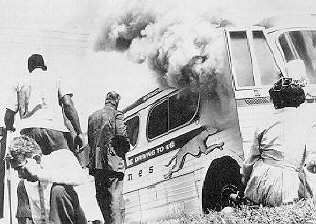 | segregation . They reasoned that if
they provoked a violent reaction, the Kennedy administration would have to enforce the law. In
Anniston, Alabama, about 200 angry whites attacked Bus Two, kicking its sides and slashing its tires
. The driver managed to take the damaged bus six miles out of town before one of the slashed tires
blew apart. The mob, which had driven after the bus, barricaded the door while someone smashed the
rear window and tossed in a fire bomb . The freedom riders forced open the door and spilled out just
before the bus exploded in a ball of flame.
NEW VOLUNTEERS
CORE’S freedom riders did not want to give up, but
the bus companies refused to carry them any farther, so they ended their ride and nearly all of them
boarded a flight to New Orleans . Then Diane Nash, a SNCC leader, called CORE director James Farmer
to say that a group of Nashville students wanted to resume the freedom ride. “You know that may
be suicide,” warned Fariner. Nash answered, “We know that, but if we let them stop us
with violence, the movement is dead! . . . Your troops have been badly battered. Let us pick up the
baton and run with it When the SNCC volunteers rode into Birmingham, Police Commissioner Eugene
“Bull” Connor’s men pulled them off the bus, beat them, and drove them into
Tennessee. The determined young people returned to Birmingham and occupied the whites-only waiting
room at the terminal, where they sat for 18 hours because the bus driver refused to risk his life
transporting them. After receiving an angry phone call from U.S. Attorney General Robert Kennedy, bus
company officials convinced the driver to proceed. The SNCC volunteers set out for Montgomery on
May20. | | |
|
|
|
1.
|
Why did groups of civil rights
workers start out on “Freedom Rides” through the South?
a. | It was safer to ride in
groups | c. | They wanted to test the Supreme
Court decision that desegregated interstate buses. | b. | Freedom busses were the only transportation available in
the South | d. | The Freedom Bus Company had the
cheapest fairs in the South |
|
|
|
2.
|
What organization sponsored the
Freedom Rides?
a. | Colored Organizations for Racial
Equality | c. | Congress Of Racial
Equality | b. | Colored Organizers for Racial Equality | d. | Congressional Officers for Ending
Racism |
|
|
|
3.
|
Who was the police commissioner
of Birmingham who tried to break up the Freedom Rides?
a. | Bull
Conners | c. | James
Farmer | b. | George Wallace | d. | James Peck |
|
|
|
4.
|
Which organization was most
aggressive and confrontational about fighting for racial integration
a. | NAACP | c. | SNCC | b. | CORE | d. | None of these were aggressive |
|
|
|
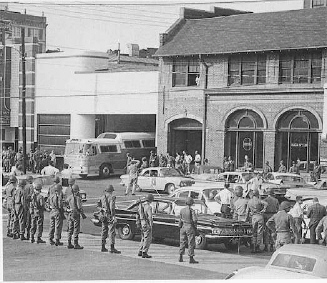 | ARRIVAL OF
FEDERAL MARSHALS
Although Alabama officials had promised Kennedy that the riders would be
protected, no police were stationed near the Montgomery terminal when the bus arrived. Instead, a mob
of whites-many carrying bats and lead pipes-fell upon the riders . John Doar, a Justice Department
official on the scene, called the attorney general and reported what happened. “A bunch of men
led by a guy with a bleeding face are beating [the passengers] . There are no cops.
It’s terrible . It’s terrible . There’s not a cop in sight. People are yelling,
‘Get ‘em, get ‘em.’ It’s awful.” The violence
| provoked exactly the response the freedom riders had been
hoping for. Newspapers throughout the nation and abroad denounced the beatings. Southern
newspapers such as the Atlanta Constitution, which had criticized the freedom ride, expressed outrage
that police had refused to protect the riders . President John F Kennedy decided to give the
freedom riders more direct support. This time, the justice Department sent 400 U.S . marshals to
protect the riders on the last part of their journey to Jackson, Mississippi. In addition, the
attorney general and the Interstate Commerce Commission issued an order banning segregation in all
interstate travel facilities, including waiting rooms, restrooms, and lunch counters
.
| | |
|
|
|
5.
|
What happened when the Freedom
Riders arrived in Montgomery, Alabama?
a. | They were beaten by the
police | c. | They were greeted by the
mayor | b. | They were beaten by an angry mob | d. | They were met by angry Justice Department
officials |
|
|
|
6.
|
What was the attitude of the
police toward the violence imposed on the Freedom Riders when they arrived in
Montgomery?
a. | They condoned
it | c. | They instigated
it | b. | They opposed
it | d. | They most likely did not know about
it |
|
|
|
7.
|
How did the Justice Department
react to the beatings of the Freedom Riders in Montgomery?
a. | They ignored the
beatings | c. | They sent federal
marshals to protect the riders | b. | They condoned the beatings | d. | They took control of the bus
company |
|
|
|
8.
|
Interstate commerce means commerce between two or more states, not just inside a state.
The U.S. government has authority over interstate commerce because it is between states. What was the
result of the Freedom Rider beatings in Montgomery?
a. | The Freedom Riders gave
up. | c. | The bus company stopped freedom
rides because they involved interstate commerce. | b. | segregation was banned on all travel facilities, including
waiting rooms, restrooms, and lunch counters by the state of
Alabama | d. | segregation was banned on all travel facilities, including
waiting rooms, restrooms, and lunch counters by the U.S.
government |
|
|
|
9.
|
What was the end result of the
Freedom Rider beatings in Montgomery, Alabama?
a. | public opinion turned in against the
Riders and segregation was banned on the busses | c. | public opinion turned in favor of the Riders and segregation was banned on the
busses. | b. | public opinion turned in favor of the police and gave them more power to
impose law and order in Montgomery | d. | the State of Georgia and the city of Montgomery came out looking like the
victims |
|
|
|
10.
|
The Interstate Commerce
Commission is an agency of
a. | the state of
Alabama | c. | the Constitution
of the United States | b. | the city of Birmingham, Alabama | d. | the United States government |
|
|
|
Standing Firm
As interstate travel
facilities became more fully integrated, some civil rights workers turned their attention to
integrating some Southern schools and pushing the movement into additional Southern towns. At each
turn they encountered opposition from some whites .
“Violence is a fearful thing,”
recalled Avon Rollins of SNCC . “I remember when I had to take a stand, where the words
wouldn’t come out of my mouth, . . . because the fear was in me so strong
.”
INTEGRATING OLE MISS
In September 1962, Air Force veteran James Meredith won a
federal court case that allowed him to enroll in the all-white University of Mississippi, nicknamed
Ole Miss. But when Meredith arrived on campus, he faced Governor Ross Barnett, who refused to let him
register as a student. Following the precedent set by Eisenhower in Little Rock, President
Kennedy ordered federal marshals to escort Meredith to the registrar’s office . Barnett
responded with a heated radio appeal : “I call on every Mississippian to keep his faith and
courage. We will never surrender.” The broadcast turned out white demonstrators by the
thousands . On the night of September 30, riots broke out on campus that resulted in two deaths . It
took more than 5,000 soldiers, 200 arrests, and 15 hours to stop the rioters . In the months that
followed, federal officials accompanied Meredith to class and protected his parents from nightriders
who shot up their house.
| |
|
|
|
11.
|
When _____ arrived on the
University of Mississippi to enroll, he was opposed by _____ .
a. | James Meredith - Governor Ross Barnett | c. | Freedom Riders - the Justice Department | b. | James Meredith - Governor George
Wallace | d. | Avon Rollins - Governor Ross
Barnett |
|
|
|
12.
|
What did the U.S. government do
in regards to the enrollment of James Meredith at “Ole Miss”
a. | Correctly stated that it was a state
matter and the U.S. government had no authority | c. | Sent marshals to protect and escort Meredith to
class | b. | Asked former President, Eisenhower to
intervene. | d. | Cut off all federal funds to the
University of Mississippi |
|
|
|
13.
|
How did the people of
Mississippi react to the radio speech of the Governor?
a. | By rioting on campus
| c. | The people ignored
it | b. | They calmed
down | d. | By dropping out of the
University |
|
|
|
HEADING INTO BIRMINGHAM By 1963, Reverend
Fred Shuttlesworth, head of the Alabama Christian Movement for Human Rights, decided that something
had to be done about Birmingham-a city known for its strict enforcement of total segregation in
public life . The city also had a reputation for racial violence, including 18 bombings from 1957 to
1963. Deciding that Birmingham would be the ideal place to test the power of nonviolence,
Shuttlesworth invited Dr. Martin Luther King, Jr., and the SCLC to help desegregate the city. On
April 3, 1963, King flew into Birmingham to hold planning meetings with members of the
African-American community. “This is the most segregated city in America,” he said.
‘We have to stick together if we ever want to change its
ways.”
After several days
of demonstrations led by Shuttlesworth and others, King led a small band of marchers into the streets
of Birmingham on Good Friday, April 12. Police Commissioner Bull Connor promptly arrested them. While
sitting in his jail cell, Dr. King wrote an open letter to white religious leaders who felt he was
pushing too hard, too fast .
On April 20, King posted bail and began to plan more demonstrations .
On May 2, more than a thousand African-American children marched in Birmingham ; Bull Connor arrested
959 of them. On May3, a second “children’s crusade” came face to face with Connor
and his helmeted police force . As television cameras recorded the scene, the police swept the
marchers off their feet with high-pressure fire hoses, set attack dogs on them, and clubbed those who
fell . Millions of TV viewers heard the children screaming. Continued protests, an economic
boycott, and negative media coverage finally convinced Birmingham officials to meet King’s
demands for an end to segregation . Birmingham offered a stunning civil rights victory that inspired
African Americans across the nation. In addition, it convinced President Kennedy that nothing short
of a new civil rights act would end the disorder and satisfy the demands of African Americans-and
many whites-for racial justice.
|
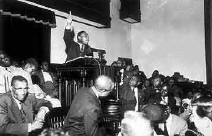
Dr King speaks in
Birmingham
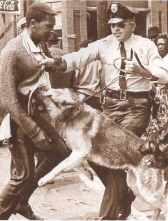
Police dogs attack
demonstrators
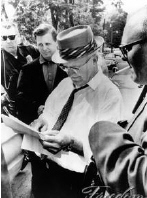
Bull Conners - Police Chief of Birmingham,
Alabama | | |
|
|
|
14.
|
Birmingham, Alabama was chosen
as a city to test the non-violent approach to ending segregation because
a. | it had a history of
violence | c. | both of these
reasons | b. | it was one of the most segregated cities in the
nation |
|
|
|
15.
|
It is safe to say that Dr. King
and the _____ was trying to _____ violence to call attention to the segregation
issue.
a. | SNCC -
provoke | c. | SCLC - avoid
| b. | SCLC - provoke
| d. | SNCC -
prevent |
|
|
|
16.
|
Which person did exactly what
his opposition wanted him to do in Birmingham.
a. | Dr.
King | c. | President John
Kennedy | b. | Reverend Fred Shuttlesworth | d. | Bull Conners |
|
|
|
17.
|
What was the result of Bull
Conners actions in Birmingham?
a. | Thousands of demonstrators were
killed | c. | The city was
desegregated | b. | The city became more segregated | d. | Most of the black children in the city were beaten and
jailed. |
|
|
|
18.
|
The events in Birmingham,
Alabama in 1963 demonstrated
a. | the fact that the American people
did not care what happened to African Americans | c. | the basic fairness of the American people when exposed to an
injustice | b. | the indifference of the Kennedy administration toward racial
injustice | d. | that the American people did not
want to integrate with African Americans |
|
|
|

George Wallace
Medgar Evers
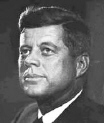
JFK
| KENNEDY TAKES A STAND
On June 11, 1963, President Kennedy used federal troops to
force Governor George Wallace to honor a court order desegregating the University of Alabama. That
evening, Kennedy addressed the nation and asked pointedly, “Are we to say to the world-and much
more importantly, to each other-that this is the land of the free, except for the Negroes?” He
referred directly to “repressive police action” and “demonstrations in the streets
.” Then, he demanded that Congress pass a sweeping civil rights bill A tragic event just hours
after Kennedy’s speech highlighted the racial tension in much of the South. Shortly after
midnight, a sniper shot and killed Medgar Evers-NAACP field secretary and World War II veteran-in the
driveway of his home in Jackson, Mississippi. Police soon arrested white supremacist Byron de la
Beckwith for the crime, but he was released after two trials resulted in hung juries . (De la
Beckwith was finally convicted in 1994, after the case was reopened based on new evidence .) The
release of de la Beckwith brought a new militancy to African Americans. With raised fists, many
demanded, “Freedom now!”


Byron de la
Beckwith Medgar
Evers
| | |
|
|
|
19.
|
Medgar Evers was
a. | a WWII veteran and NAACP field
worker | c. | Governor of
Alabama | b. | President of the U.S. | d. | charged with murder |
|
|
|
20.
|
JFK was
a. | a WWII veteran and NAACP field
worker | c. | charged with
murder | b. | President of the U.S. | d. | Governor of Alabama |
|
|
|
21.
|
Beckwith
was
a. | Governor of
Alabama | c. | charged with
murder | b. | President of the U.S. | d. | a NAACP field worker |
|
|
|
22.
|
George Wallace
was
a. | charged with
murder | c. | an NAACP field
worker | b. | Governor of Alabama | d. | leader of SNNC |
|
|
|
23.
|
What did Kennedy ask Congress
to do?
a. | pass a civil rights
bill | c. | send marshals to Alabama to enforce
segregation | b. | send troops to Alabama to protect
demonstrators | d. | send marshals to Alabama to enforce
integration |
|
|
|
24.
|
Byron de la Beckwith was
arrested and convicted in 1963 for shooting Medgar Evers
|
|
|
25.
|
How did African Americans react
to the trial of de la Beckwith in 1963?
a. | satisfaction | c. | anger | b. | sadness | d. | anticipation |
|
|
|
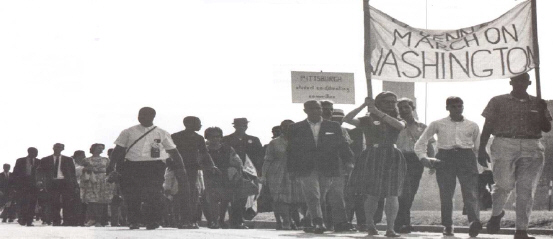 | Marching to Washington
The civil rights bill
that Kennedy sent to Congress guaranteed equal access to all public accommodations and gave the U.S.
attorney general the power to file school desegregation suits. To persuade Congress to pass the bill,
two veteran organizers-labor leader A. Philip Randolph and Bayard Bustin of the SCLC summoned
Americans to join in a massive march on Washington, D.C.
THE DREAM OF EQUALITY
On August
28, 1963, more than 250,000 people including about 75,000 whites-converged on the nation’s
capital. They assembled on the grassy slopes of the Washington Monument, and the movement’s
leaders, walking arm in arm, led the crowd to the sprawling plaza near the Lincoln Monument. There,
for more than three hours, people listened to speakers demand the immediate passage of the civil
rights bill. When Dr. Martin Luther King, Jr., appeared, the crowd exploded in applause . King
eventually stopped reading from his prepared text and began an improvised speech in which he appealed
for peace and racial harmony, punctuating his speech with the repeated refrain “I have a
dream.”
MORE VIOLENCE
Two weeks after King’s historic speech, a car sped past
the Sixteenth Street Baptist Church in Birmingham, Alabama, and a rider in the car hurled a bomb
through one of the church “windows. The resulting explosion claimed the lives of four
young girls .
Two more African Americans died in the unrest that followed. Two months
later, on November 22, 1963, an assassin shot and killed John F. Kennedy. (See Chapter 20.) His
successor, President London B. Johnson, pledged to carry on Kennedy’s work by winning passage
of the civil rights bill. “We have talked for 100 years or more,” Johnson said. “It
is time now to write the new chapter-and to write it in books of law.” On July 2, 1964,
President Johnson signed the Civil Rights Act of 1964, which prohibited discrimination because of
race, religion, national origin, and gender. It gave all citizens the right to enter libraries,
parks, washrooms, restaurants, theaters, and other public accommodations
.
| |
|
|
|
26.
|
The civil rights bill that
Kennedy sent to Congress
a. | guaranteed equal access to all
public accommodations | c. | gave the U.S.
attorney general the power to file school desegregation suits | b. | both of these | d. | Neither of these. Kennedy was luke- warm on civil
rights |
|
|
|
27.
|
Why did A. Philip Randolph and Bayard Bustin of the SCLC organize the “March on
Washington?”
a. | demand better housing for black
people | c. | pressure Congress to pass the civil
rights bill | b. | demand and end to school integration | d. | protest the war in Vietnam |
|
|
|
28.
|
Dr. King’s “I Have
A Dream” speech
a. | was carefully prepared to get just
the right response from the abundance | c. | was a spontaneous speech from his heart | b. | was written by Bayard Bustin and A. Philip
Randolph | d. | surprised people because it was full
of anger, frustration and some hate. |
|
|
|
29.
|
The March on Washington seemed
to have a calming effect on the citizens of Birmingham, Alabama
|
|
|
30.
|
When was John F.Kennedy
assassinated?
a. | Nov. 22,
1964 | c. | January,
1963 | b. | Nov 22, 1963 | d. | January, 1964 |
|
|
|
31.
|
What happened to the civil
rights bill after Kennedy was assassinated?
a. | It died in
Congress | c. | Johnson pushed it
through Congress | b. | It was defeated in the Senate | d. | Johnson let it die and did not push
it |
|
|
|
32.
|
What happened on July 2,
1964?
a. | President Johnson signed the Civil
Rights Bill | c. | President Kennedy
was shot | b. | President Kennedy signed the Civil Rights
Bill | d. | President Johnson forgot to sign the Civil Rights Bill
because he was working out with Mr. Schneemann |
|
|
|
Fighting for Voting
Rights
Meanwhile, civil rights
workers in the South were planning a different campaign to influence the country’s laws-by
registering African-American voters who could elect legislators who supported civil rights .
Because previous voter-registration drives had met with little success, CORE and SNCC planned a much
larger effort for 1964. They hoped their campaign would receive national publicity that would in turn
influence Congress to pass a voting rights act. SNCC concentrated its efforts in Mississippi, in a
project that was popularly known as Freedom Summer.
FREEDOM SUMMER
SNCC knew that challenging the system that kept more than 90 percent of
African-American citizens from the polls would be a daunting task. Civil rights groups recruited
white students from colleges across the country and then trained them in the techniques of nonviolent
resistance . Some 1,000 volunteers-mostly white, about one-third finally-went into Mississippi to
help the mostly African-American SNCC staff members register voters .
Robert Moses, a former New
York City schoolteacher who had quit his job and joined SNCC in 1961, led the voter project in
Mississippi. By the summer of 1964, Moses had already been working for several years in Mississippi
to register blacks to vote. “Mississippi has been called ‘The Closed Society.’ It
is closed, locked,” Moses said. “We think the key is in the
vote.”
Immediately, the voter
project encountered violent opposition . In June, while some of the volunteers were still receiving
training back in Ohio, three civil rights workers, including one summer volunteer, disappeared in
Mississippi . They were Michael Schwerner and Andrew Goodman, white activists from New York, and
James Chaney, an African American from Mississippi . Investigators later learned that Klansmen, with
the support of local police, had murdered the three and buried them in an earthen dam . By the end of
the summer, the project had suffered 4 dead, 4 critically wounded, 80 beaten, and dozens of
African-American churches and businesses bombed or burned. In spite of all the publicity the project
received, Congress still did not pass a voting rights act
| |
|
|
|
33.
|
What was CORE and SNCC trying
to do in Mississippi during the Summer of 64?
a. | Get black people registered to
vote | c. | Fight Bull Conners in
Birmingham | b. | Protest against discrimination in interstate
commerce. | d. | Protect black people from the KKK in
the South. |
|
|
|
34.
|
What did CORE and SNCC want the
U.S. government to do
a. | protect the protestors on
busses | c. | pass an anti poverty
bill | b. | pass a voting rights act | d. | go after the KKK |
|
|
|
35.
|
Many people thought that
Mississippi was a closed society to black people. They could not improve their living conditions and
could not even acquire basic civil rights. What did the civil rights organizers see as the key to
open the state for black people.
a. | better
jobs | c. | total integration of the
schools | b. | a stronger NAACP | d. | voting rights for black people |
|
|
|
36.
|
Freedom Summer was the first
Summer in years free of violence against civil rights workers.
|
|
|
37.
|
Because of the hard work and
dedication of the civil rights workers during Freedom Summer, the Voting Rights Act was finally
passed in the fall.
|
|
|
A NEW POLITICAL PARTY
The Democrat party had controlled
the South since the Civil War. They were in favor of segregation and created the Jim Crow laws. To be
elected to political office in the South you had to be a Democrat. To challenge Mississippi’s
white-controlled Democratic Party, SNCC organized the Mississippi Freedom Democratic Party (MFDP) .
Open to anyone, regardless of race, the MFDP hoped to unseat Mississippi’s regular party
delegates at the Democratic National Convention .
Fannie Lou Homer, the daughter of Mississippi
sharecroppers, won the honor of speaking for the MFDP at the convention . Hamer had registered to
vote in 1962 at the cost of a crippling beating and her family’s eviction from their faun. In
June 1964, she spoke to the credentials committee at the Democratic convention in a prime-time
televised address . Hamer described how she had been arrested for trying to register and taken to
jail, where police forced other prisoners to beat her.
In response to Hamer’s speech, telegrams and
telephone calls poured in the convention in support of seating the MFDP delegates . But President
Johnson feared that such a move would cost him white votes throughout the South, so his
administration pressured civil rights leaders to convince the MFDP to accept a compromise. The
Democrats would give 2 of Mississippi’s 68 seats to the MFDP, with a promise to ban
discrimination at the 1968 convention. When Hamer learned of the compromise, she exclaimed, “We
didn’t come all this way for no two seats when all of us is tired.” The MFDP and many of
their young supporters in SNCC felt that the leaders of other civil rights groups had betrayed them.
This sense of betrayal was one of several factors that eventually led to conflict among various civil
rights groups
| |
|
|
|
38.
|
What was the goal of the
Mississippi Freedom Democratic Party (MFDP)?
a. | gain power in the regular Democrat
party | d. | all of
these | b. | get some seats for black people in the Democrat convention in
1964 | e. | none of these | c. | gain political power in
Mississippi |
|
|
|
39.
|
SNCC and MFDP
believed
a. | they were betrayed at the Democrat
National Convention | c. | they were now the
most important and powerful political force in Mississippi | b. | they had won a victory at the Democrat Convention
| d. | the regular Democrat party was a friend of black
people |
|
|
|
40.
|
Why did SNCC believe it needed
its own political party in Mississippi?
a. | the regular Democrats in Mississippi
were controlled by people who were friendly to civil rights but they had little real political
power | c. | the regular Democrat party in
Mississippi was against racial integration and at the same time controlled the
state | b. | the Republicans controlled the South and it was the only way to defeat
them | d. | they could not raise money without the organization of
regular political party |
|
|
|
THE SELMA CAMPAIGN
Voting in the
United States is a two step process. First you must register with the country to prove you are a
citizen and then you can vote on election day. In the South black people usually did not register so
they could not vote. They did not register for a variety of reasons: some states had literacy
requirements which said you needed to be able to read and write, sometimes blacks felt intimidated,
sometimes they had to pay a poll tax to register, sometimes they were not motivated because the only
candidates were pro segregationists.
At the start of 1965, the SCLC decided to conduct a
major campaign in Selma, Alabama, where SNCC had been working for two years to register voters .
African Americans accounted for more than half of Selma’s population but for only about 3
percent of the total registered voters . Martin Luther King, Jr., and the SCLC hoped that a
concentrated voter-registration drive in Selma would provoke a hostile white response-which would
help convince the Johnson administration of the need to sponsor a federal voting-rights law.
By the end of January 1965, more than 2,000 African Americans had been arrested in
demonstrations . Selma sheriff Jim Clark reacted as violently as Bull Connor in Birmingham, and his
men brutally attacked civil rights demonstrators Then, in February, law officers shot and killed a
demonstrator named Jimmie Lee Jackson. Dr.King responded by announcing a 50-mile protest march from
Selma to the state capital, Montgomery. On Sunday, March 7, 1965, a group of about 600 protesters set
out for Montgomery.That night, news bulletins interrupted regular television programs to show what
looked like a war. Clouds of tear gas swirled around fallen marchers, while police wearing gas masks
and riding horses swung whips and clubs. The scene sent shock waves across the country. Demonstrators
from all over the United States poured into Selma to join the march. President Johnson responded by
asking Congress for the swift passage of a new voting rights act. In his speech, Johnson openly
embraced the rhetoric of the civil rights movement. Said the president, “Their cause must be
our cause, too. It is not just Negroes, but all of us, Who must overcome the crippling legacy of
bigotry and injustice . And we shall overcome .” On Sunday, March 21, 3,000 marchers again set
out for Montgomery~; this time with federal protection. Two Nobel Peace Prize winners-Dr. Martin
Luther King, Jr., and UN diplomat Ralph Bunche-led the procession . Under court order, only 250
marchers were supposed to enter the city limits, but nothing could stop the groundswell of support.
An army of some 25,000 demonstrators joined the marchers as they walked into
Montgomery
| |
|
|
|
41.
|
Why did Dr. King try to provoke
violence against the civil rights workers and marchers?
a. | Gain the sympathy of the General
Public | c. | Motivate his
workers | b. | Frighten President Johnson into supporting a new voting rights
law | d. | All of these are
reasons |
|
|
|
42.
|
Before you can vote in the
United States you must
a. | pay all traffic tickets and
fines | c. | have a high school
education | b. | register | d. | prove you could read and write |
|
|
|
43.
|
In what southern city did SCLC
and SNCC focus their attention because only about 3% of the voters were African American while their
percentage of the total population was more than half.
a. | Montgomery,
Alabama | c. | Selma,
Alabama | b. | Little Rock, Arkansas | d. | Selma, Mississippi |
|
|
|
44.
|
The march to Selma started with
about 600 marchers. How did sheriff Jim Clark react to the
marchers?
a. | violently with tear gas and
clubs | c. | called out the National
Guard | b. | He protected the marchers from the mobs of people who came to break up the
march | d. | resigned rather than follow the mayor’s orders to
break up the march |
|
|
|
45.
|
The reaction of sheriff Jim
Clark to the Selma civil rights marchers
a. | horrified the leaders of SNCC and
SCLC | c. | was just the response that Dr. King,
SNCC and SCLC wanted | b. | angered Dr. King | d. | did not get shown to the rest of the country on
television |
|
|
|
46.
|
Who was the black United
Nations diplomat from the U.S. who marched with Dr. King in Selma?
a. | Dr. Bull
Conners | c. | Dr. Ralph
Bunche | b. | Dr. Ralph Clark | d. | Dr. Jim Crow |
|
|
|
VOTING RIGHTS ACT OF 1965
Ten weeks after the
Selma-to-Montgomery march, Congress passed the Voting Rights Act of 1965 . The act eliminated the
literacy test that had disqualified so many voters . The act also stated that federal examiners could
enroll voters denied suffrage by local officials. In Selma, the proportion of eligible African
Americans who were registered to vote rose from 10 percent in 1964 to 60 percent in 1968. Overall the
percentage of registered African-American voters in the South tripled. Although the Voting
Rights Act marked a major civil rights victory, some African Americans felt that the law did not go
far enough. Centuries of segregation and discrimination had produced deep-rooted social and economic
inequalities. In the mid-1960s, anger over these inequalities led to a series of violent disturbances
in the cities of the North. | |
|
|
|
47.
|
The Voting Rights Act on 1965
said that the U.S. government could register voters if they were denied voting rights by local
communities and also said that a person did not have to know how to read and write to register to
vote.
a. | true | c. | partly true and partly
false | b. | false |
|
|
|
48.
|
The Voting Rights Act of 1965
_____ the number of African American voters eligible to vote.
a. | decreased to
60% | c. | increased to
60% | b. | increased to 100% | d. | did not effect |
|
|
|
49.
|
Black people were satisfied
that they had full political power now that they had the Voting Rights Act of
1965
|
|
|
50.
|
What does suffrage
mean?
a. | The right to protest and not have to
suffer | c. | The persecution of African Americans
in the South | b. | The right to march and not have to suffer | d. | The right to vote |
|
|
|
The Segregation
System
Segregated buses might
never have rolled through the streets of Montgomery or anywhere else in the United States-if the
Civil Rights Act of 1875 had remained in force. This act outlawed segregation in public facilities by
decreeing that “all persons . . . shall be entitled to the full and equal enjoyment of the
accommodations . . . of inns, public conveyances on land or water, theaters, and other places of
public amusement.” In 1883, however, the Supreme Court declared the act
unconstitutional
| | PLESSY V. FERGUSON
During the 1890s, a number of other court decisions and
state laws severely limited African-American rights . In 1890, Louisiana passed a law requiring
railroads to provide “equal but separate accommodations for the white and colored races.”
In the Plessy v. Ferguson case in 1896, the Supreme Court ruled that this law did not violate the
Fourteenth Amendment, which guarantees all Americans equal treatment under the
law.
Armed with the Plessy
decision, states throughout the nation, but especially in the South, passed what were known as Jim
Crow laws, or laws aimed at separating the races. Laws forbade marriage between blacks and whites and
established many other restrictions on social and religious contact between the races . There were
separate schools, as well as separate streetcars, waiting rooms, railroad coaches, elevators, witness
stands, and public restrooms. The facilities provided for blacks were always far inferior to those
provided for whites . Nearly every day, African Americans faced humiliating signs that read, Colored
Water; No Blacks Allowed; Whites Only. | | |
|
|
|
51.
|
In 1873 a civil rights act was
passed that made segregation unconstitutional in the United States. If this is true, why did
segregation continue until the late 1900’s?
a. | The government refused to enforce
the law | c. | People in the
North ignored the law | b. | The Supreme Court said the law was
unconstitutional | d. | People in the South ignored the
law |
|
|
|
52.
|
The 14th Amendment to the U.S.
Constitution says that the law must be applied equally to all citizens. In the Plessy v. Ferguson case in 1896, what did the Supreme Court rule?
a. | The U.S. government should not
interfere in segregation cases. | c. | Separate facilities for the races did not violate the 14th
Amendment | b. | Slavery is unconstitutional | d. | Separate facilities for the races did violate the 14th
Amendment |
|
|
|
53.
|
What were Jim Crow
laws?
a. | Laws designed to separate the
races | c. | Law that forbid the sale of bourbon
whisky to African Americans | b. | Laws designed to bring the races together | d. | Laws designed to protect black
people |
|
|
|
SEGREGATION
CONTINUES INTO THE 20TH
CENTURY
In the late 1800s, some
African Americans tried to escape Southern racism by moving north. This migration of Southern African
Americans speeded up greatly during World War I, as many African-American sharecroppers abandoned the
farms for the promise of industrial jobs in Northern cities . However, once African Americans reached
the North, they discovered that racial prejudice and segregation patterns existed there as well. Most
African Americans could find housing only in all black neighborhoods. In addition, many white workers
resented competition from blacks, resentment which sometimes led to violence . |
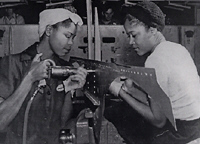
African American war
plant workers | | In many ways, the events of World War II
set the stage for the civil rights movement. First, the demand for soldiers in the early 1940s
created a shortage of white male laborers, which opened up new job opportunities for African
Americans, Latinos, and white women. Second, about 700,000 African Americans served in the
armed forces, which needed so many fighting men that they gradually had to end discriminatory
policies that had kept African Americans from serving in fighting units. Many African-American
soldiers returned from the war determined to fight for their own freedom now that they had helped
defeat Fascist regimes overseas . Third, during the war, civil rights organizations actively
campaigned for African-American voting rights and challenged Jim Crow laws. In response to protests,
President Roosevelt issued a presidential directive prohibiting racial discrimination by federal
agencies and all companies that were engaged in war work. The groundwork was laid for more organized
campaigns to end segregation throughout the United States. | | |
|
|
|
54.
|
During the 20th century many
African Americans moved from the South to the North. What was the main motivation for this
migration?
a. | The civil rights movement was
stronger in the North | c. | In the North there
was no segregation | b. | Good paying factory jobs in the North | d. | Martin Luther King encouraged blacks to move
North |
|
|
|
55.
|
Which World War II events
motivated black people to want more civil rights and set the stage for the civil rights
movement of the 50’s and 60’s?
a. | Black men serving in the
military | d. | Roosevelt
declaring an end to segregation in war industries | b. | Blacks working in the war
plants | e. | All of these set the state for the civil rights
movement | c. | Civil rights leaders campaigned for an end to Jim Crow laws and for voting
rights |
|
|
|
56.
|
In World War II African
Americans
a. | secretly wanted Japan to win the war
because they were not white | c. | were pro American patriots who worked and fought for the United
States | b. | agreed with the Black Muslims who refused to help the U.S. in the
war | d. | hated the United States because of
segregation |
|
|
|
Challenging
Segregation in Court
Since 1909, the NAACP had fought to end segregation. One influential
figure in this campaign was Charles Hamilton Houston, a brilliant Howard University professor who
trained African-American law students and who also served as chief legal counsel for the NAACP from
1934 to 1938.
| 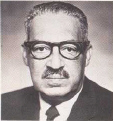
Thurgood
Marshall | THE NAACP LEGAL STRATEGY - In
deciding the NAACP’s legal strategy, Houston considered the blatant inequality between the
separate schools many states provided for the two races . At that time, the nation spent ten times as
much money educating a white child as it did educating an African-American child. It was to redress
this injustice that Houston chose to focus the organization’s limited resources on challenging
segregated public education .
For help, Houston recruited some of his most able law students
to prepare a battery of cases to take before the Supreme Court. In 1938, he placed the team under the
direction of Thurgood Marshall. Over the next 23 years, Marshall and his NAACP lawyers would win 29
out of 32 cases argued before the Supreme Court. Several of the cases that Marshall and his team of
lawyers won became legal milestones, each one chipping away at the segregationist tenets of Plessy v.
Ferguson .
· In the 1946 case
Morgan v. Virginia, the Supreme Court declared unconstitutional those state laws mandating
segregated seating on interstate buses .
· In 1950, the high court
ruled in Sweatt v. Painter that state law schools must admit black applicants, even if
separate black schools exist.
·
In another 1950 case that Marshall and his team argued, the court ruled
that blacks admitted to state graduate schools were entitled to the use of all the school’s
facilities.
· BROWN V. BOARD OF EDUCATION Marshall’s most stunning victory came on May
17, 1954, in the case known as Brown v. Board of Education of Topeka, Kansas . In this case, the
court responded to a brilliant legal brief written by Marshall that addressed segregated education in
four states-Kansas, South Carolina, Virginia, and Delaware. The court lumped the state cases together
in a single ruling named for the case concerning nine-year-old Linda Brown. Her father, Oliver Brown,
had charged the board of education of Topeka with violating Linda’s rights by denying her
admission to an all-white elementary school four blocks from her house. The state had directed Linda
to cross a railroad yard and then take a bus to an all-black elementary school 21 blocks away.
In a landmark verdict, the Supreme Court unanimously struck down segregation as unconstitutional .
The Court’s decision, written by Chief Justice Earl Warren, in part stated the
following.
To
separate [African-American children] from others of similar age and qualifications solely
because of their race generates a feeling of inferiority as to their status in the community that may
affect their hearts and minds in a way unlikely ever to be undone. . . . We conclude that in the
field of public education the doctrine of “separate but equal” has no place. Separate
educational facilities are inherently unequal .
CHIEF JUSTICE EARL WARREN, Brown v. Board of
Education
| | |
|
|
|
57.
|
How did Charles Hamilton Houston decide to attack racism?
a. | In the
streets | c. | In the
courts | b. | In the workplace | d. | In the inner city |
|
|
|
58.
|
Charles Hamilton Houston was
especially upset of inequality in
a. | the work
place | c. | in the
churches | b. | in the schools | d. | in the military |
|
|
|
59.
|
What was the 1946 case Morgan v. Virginia case concerned with?
a. | segregation in the
workplace | c. | segregation in
transportation | b. | segregation in the military | d. | segregation in schools |
|
|
|
60.
|
What was the Sweatt v. Painter case about
a. | admission of black applicants to law
schools | c. | work place
segregation | b. | promotion of blacks in the military | d. | admission of black men to medical
colleges |
|
|
|
61.
|
What was the name of the very
able African American lawyer who worked with the NAACP for 23 years and won 29 of the 32
cases he argued before the Supreme Court?
a. | Plessy
Fergusson | c. | Charles
Hampton | b. | Charles Houston | d. | Thurgood Marshall |
|
|
|
62.
|
What was the Brown v Board of
Education case all about?
a. | A nine year old girl, Linda Brown,
was not allowed to go to a white school 4 blocks from her house because she was
black | c. | Linda Brown was not permitted to go
to an all black school, just 4 blocks from her house. | b. | Linda Brown, a white girl, was forced to go to an all
black school as part of a forced integration plan for Topeka,
Kansas | d. | Linda Brown could not go to school because there were not
black schools in Topeka, Kansas |
|
|
|
63.
|
There are 9 judges on the
Supreme Court. How many voted to end segregation in the Brown v Board of Education
case.
|
|
|
64.
|
Earl Warren was a conservative
Republican appointed to the Supreme Court by Republican President, Dwight Eisenhower. How did Warren
feel about segregation in public schools?
a. | He was in favor of segregation as
long as the schools for blacks and whites were equal | c. | He was opposed to segregated schools because black and white school were
inherently unequal | b. | He was not if favor of segregated schools, even though he thought black and
white schools could be equal | d. | He had no opinion about segregated
schools and thought the U.S. government should stay out of the
controversy. |
|
|
|
65.
|
The Brown v Board of Education
decision was based on the 14th Amendment to the Constitution of the U.S. What constitutional
principle is part of the 14th Amendment.
a. | free
speech | c. | equal protection of the
law | b. | freedom of the press | d. | the right to have a lawyer in
court |
|
|
|
Reaction to the Brown
Decision
The ruling thrilled
African Americans and many other Americans . “I was so happy, I was numb,” declared
Thurgood Marshall . The Chicago Defender, an African-American newspaper, pronounced,
“[It’s] a second emancipation proclamation .” The Brown decision
immediately affected some 12 million school children in 21 states . Official reaction to the ruling
was mixed. In Kansas and Oklahoma, state officials said they expected segregation to end with little
trouble. In Texas the governor promised to comply but warned that plans might “take
years” to work out. In Mississippi and Georgia, officials vowed total resistance. Governor
Herman Talmadge of Georgia branded the decision “a flagrant abuse of judicial power” and
pledged, “The people of Georgia . . . will map a program to insure . . . permanent segregation
of the races .” | |
|
|
|
66.
|
How did the states react to the
Brown v Board of Education decision?
a. | The reaction was solidly against the
decision | c. | The reaction was
mixed | b. | The reaction was solidly for the decision | d. | The states did not react to the
decision |
|
|
|
RESISTANCE TO SCHOOL INTEGRATION
Within a year of the Brown
decision, more than 500 school districts in the nation had desegregated their classrooms. In
the cities of Baltimore, St. Louis, and Washington, D.C ., African-American and white students sat
side by side for the first time in history.
However, in areas where African Americans made up the
majority of the population, whites often resisted desegregation because they feared losing control of
the schools . In some places, the Ku Klux Klan reappeared and White Citizens Councils boycotted
businesses that supported desegregation. To hasten compliance, the Supreme Court handed down a second
Brown. ruling in 1955 that ordered district courts to implement school desegregation “with all
deliberate speed.” Neither Congress nor President Eisenhower moved to put teeth into the court
order. In Congress, more than 90 Southern members issued the “Southern Manifesto,” which
denounced the Brown decision and called on the states to resist it “by all lawful means.”
Although the president accepted the Courts ruling as law, he also confided privately to an aide,
“The fellow who tries to tell me that you can do these things by force is just plain nuts
.” Events in Little Rock, Arkansas, would soon force Eisenhower to act against this
belief. | |
|
|
|
67.
|
Why were white people afraid in
districts where black people made-up a majority of the citizens?
a. | Whites were afraid that they would
have to incorporate “black studies” into the curriculum | c. | Whites were afraid they would loose control of the
schools | b. | Whites were afraid blacks and whites would have to go to school
together | d. | Whites were afraid of the increased
costs of educating black students |
|
|
|
68.
|
A second Brown decision was
handed down by the Supreme Court in 1955. What did it say.
a. | The schools can take as much time as
they needed to desegregate | c. | The schools did not have to desegregate if they were planning on a challenge
to the 1954 Brown decision | b. | The schools must desegregate right away | d. | The schools must segregate right
away |
|
|
|
69.
|
In Congress, more than 90
Southern members issued the “Southern Manifesto,” What did it say?
a. | States should use any lawful means
to resist desegregation | c. | States should use
any means, even violence, to resist desegregation | b. | States should use any lawful means to resist
segregation | d. | States should use any means, even
violence, to resist segregation |
|
|
|
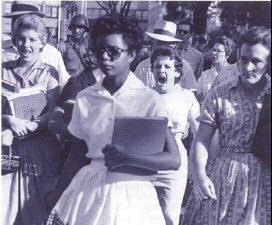 CRISIS IN LITTLE ROCK CRISIS IN LITTLE ROCK
In 1948, Arkansas had become the first Southern state to
admit African Americans to the state universities without being required by a court order. By the
1950s, some scout troops and labor unions in Arkansas had quietly ended their Jim Crow practices. In
Little Rock itself; citizens had elected two men to the school board who publicly backed
desegregation-and the school superintendent, Virgil Blossom, had been working on a plan for gradual
desegregation since 1953. However, state politics created an explosive situation . Caught in a tight
reelection race, Governor Orval Faubus jumped on the segregationist bandwagon . In September 1957, he
ordered the National Guard to turn away the nine African-American students who had volunteered to
integrate Little Rock’s Central High School as the first step in Blossom’s
| plan.
That afternoon, a federal judge ordered Faubus to let the students into school the next day. Eight
members of the “Little Rock Nine” received phone calls from ministers who volunteered to
escort the students to school for their safety. The family of the ninth student, Elizabeth Eckford,
did not have a phone . The next morning, she put on the carefully ironed white-and-black dress she
had made for her first day at an integrated school and set out alone . On the sidewalk outside
Central High, Eckford faced an abusive crowd of students and adults . Terrified, the 15-year-old
Eckford searched the mob for a friendly face. “I looked into the face of an old woman, and it
seemed a kind face,” she later told one interviewer. “But when I looked at her again, she
spat on me.” Trailed by the mob, Eckford managed to make it to a bus stop, where two friendly
whites stayed with her until the bus came. Eisenhower placed the Arkansas National Guard
under federal control and ordered a thousand paratroopers into Little Rock. Under the watchful eye of
these soldiers, the nine African American teenagers attended class. But even these soldiers could not
protect the students from troublemakers who confronted them on stairways, in the halls, and in the
cafeteria. Nor could the soldiers block interference by Faubus, who shut down Central High at the end
of the school year rather than let integration continue.
| | |
|
|
|
70.
|
Why did Governor Orval Faubus try to stop integration of Little
Rock Central High School?
a. | He was an old time
segregationist | c. | He did not try to
block integration at Central High School | b. | He thought integration would cost the city too much
money | d. | He was trying to be popular with the voters of
Arkansas |
|
|
|
71.
|
_____ was governor of _____
during the _____ high school incident in Little Rock.
a. | Orville Faubus - Alabama -
Central | c. | George Wallace -
Alabama - Northeast | b. | Orville Faubus - Arkansas - Central | d. | George Wallace - Mississippi -
Lincoln |
|
|
|
72.
|
Who did Governor Faubus use to
turn away the black students who were trying to enroll in Central High School.
a. | The Little Rock Police
force | c. | The Arkansas Highway
Patrol | b. | The Little Rock National Guard | d. | The Arkansas National Guard |
|
|
|
73.
|
What did President Eisenhower
do to force Central High School to accept the 9 black students?
a. | made Central High School a Federal
High School so it was no longer under the control of Arkansas | c. | placed the Arkansas National Guard under federal control
and ordered a thousand paratroopers into Little Rock | b. | Eisenhower did nothing because he was against integration
of the schools | d. | Eisenhower did nothing because he
was afraid |
|
|
|
74.
|
At the end of the school year,
what did Governor Faubus do to Central High School in Little Rock Arkansas?
a. | finally allowed the school to be
integrated | c. | made it a private
school | b. | turned the school into an all black high
school | d. | shut the high school rather than
integrate |
|
|
|
75.
|
In the United States the
schools are under the control of the states. What gave the U.S. government the right to force the
schools in Little Rock, Arkansas to integrate?
a. | the Brown v Board of Education
decision by the U.S. Supreme Court | c. | The U.S. government had no right to force the states to
integrate | b. | the Brown v Board of Education decision by the state
courts | d. | The Plessy v Ferguson decision by the Supreme Court of the
U.S. |
|
|
|
The Montgomery
Bus Boycott
The face-to-face confrontation at Central High School was not the only
showdown over segregation in the mid-1950s. Impatient with the slow pace of change in the courts,
African-American activists had begun taking direct action to win the rights promised to them by the
Fourteenth and Fifteenth Amendments to the Constitution .The Fourteenth Amendment promised
“equal protection of the law” (everyone in America should be treated equally. The
Fifteenth Amendment extended the right to vote to African American men by stating that race should
not be used to deny the right to vote. Among those on the frontline of change was Rosa
Parks. |
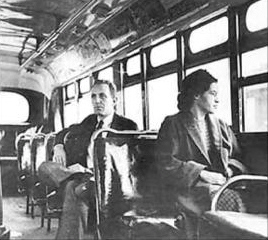 | | Long before December 1955, Rosa
Parks had protested segregation through everyday acts . She refused to use drinking fountains
labeled “Colored Only .” When possible, she shunned segregated elevators and climbed
stairs instead . Parks joined the Montgomery chapter of the NAACP in 1943 and became the
organization’s secretary. A turning point came for her in the summer of 1955, when she attended
a workshop at the Highlander Folk School in Monteagle, Tennessee . Highlander’s program was
designed to promote integration by giving the students the experience of interracial living .
Returning to Montgomery, Parks was even more determined to fight segregation . As it happened, her
act of protest against injustice on the buses inspired a whole community to join her
cause | | |
|
|
|
76.
|
What does the 14th Amendment
guarantee to every American?
a. | The right to
vote | c. | That the laws will be applied
equally to everyone | b. | The right to a happy life | d. | That everyone will get an equal
education |
|
|
|
77.
|
The 15th Amendment guarantees
that _____
a. | everyone living in the U.S. has the
right to vote | c. | African American
men and women shall have the right to vote. | b. | the right to vote will not be denied because of a persons
race | d. | the laws will be applied equally to black and white
people |
|
|
|
78.
|
Rosa Parks protested the Jim
Crow laws by .....
a. | refusing to use “colored
only” facilities. | c. | by picketing the
Montgomery bus company | b. | by picketing the Alabama state house | d. | by refusing to attend black
churches |
|
|
|
79.
|
From the reading it is clear
that Rosa Parks was interested in promoting
a. | “Black
Power” | c. | African American
businesses, such as a Montgomery bus company | b. | segregated facilities in
Alabama | d. | integration of the
races. |
|
|
|
BOYCOTTING
SEGREGATION
Among those on the frontline of change was Jo Ann Robinson. Four days after
the Brown decision in May 1954, Robinson wrote a letter to the mayor of Montgomery, Alabama, asking
that bus drivers no longer be allowed to force riders in the “colored” section to yield
their seats to whites. “More and more of our people are already arranging with neighbors and
friends for rides to keep from being insulted and humiliated by bus drivers,” Robinson warned .
The mayor refused.
On December 1,
1955, Rosa Parks, a seamstress and an NAACP officer, took a seat in the front row of the
“colored” section of a Montgomery bus. As |
| the bus filled up, the driver ordered Parks and three other African-American passengers
to empty the row they were occupying so that a white man could sit down without having to sit next to
any African Americans. “It certainly was time for someone to stand up,” recalled Parks
wryly. “So I refused to move.” As Parks stared out the window, the bus driver said,
“If you don’t stand up, I’m going to call the police and have you arrested .”
The soft spoken Parks replied, “You may do that.”
News of Parks’s arrest spread
rapidly. Jo Ann Robinson and NAACP leader E . D. Nixon quickly organized a boycott of the buses . The
leaders of the African-American community, including many ministers, formed the Montgomery
Improvement Association to organize the boycott. They elected the pastor of the Dexter Avenue Baptist
Church, 26-year-old Dr. Martin Luther King, Jr., to lead the group. “Well, I’m not sure
I’m the best person for the position,” King confided to Nixon. “But if no one else
is going to serve, I’d be glad to try. | | |
|
|
|
80.
|
Jo Ann Robinson warned the
mayor of Montgomery, Alabama that black people were tired of being humiliated on the bus system and
were planning to take action. What was the mayor’s response?
a. | He suggested that they sit down and
talk | c. | He called out the National
Guard | b. | He told her that the Montgomery bus system would never be
integrated. | d. | He ignored
her. |
|
|
|
81.
|
What did Rosa Parks
do?
a. | She brought the issue of bus
segregation to the forefront | d. | She did all of these things | b. | She challenged Jim Crow
laws | e. | She did all of these things except challenge Jim Crow
laws | c. | She focused attention on the inequities of segregation in the
South. |
|
|
|
82.
|
What did the African American
community do in response to the arrest of Rosa Parks
a. | Called a general strike against all
Montgomery businesses | c. | Rioted and burned
many Montgomery busses | b. | Organized a boycott the bus system | d. | Lay in the streets and refused to allow any busses to
pass. |
|
|
|
83.
|
_____ was elected leader of the
Montgomery Improvement Association which was organized to lead a _____
a. | Martin Luther King - riots against
white owned businesses, including the but system | c. | Martin Luther King - boycott of the bus
system | b. | Jo Ann Robinson. - boycott of the bus system | d. | Rosa Parks - fight bus
segregation |
|
|
|
WALKING FOR JUSTICE
On the night of December 5,
1955, an estimated crowd of 5,000 people gathered to hear the young pastor speak. With passion and
eloquence. Dr. King made the following declaration.
There comes a time when people get
tired of being trampled over by the iron feet of oppression . . . . I want it to be known-that
we’re going to work with grim and bold determination-to gain justice on buses in this city .
And we are not wrong . . . . If we are wrong-the Supreme Court of this nation is wrong. If we are
wrong-God Almighty is wrong. . . . If we are wrong-justice is a lie.
The impact of
King’s speech-the rhythm of his words, the power of his rising and falling voice brought people
to their feet. A sense of mission filled the audience as King proclaimed, “If you will protest
courageously and yet with dignity, historians will have to pause and say, ‘There lived a great
people-a black people-who injected a new meaning and dignity into the veins of
civilization.”’ For 381 days, African Americans refused to ride the buses in
Montgomery. In most cases, they had to find other means of transportation by organizing car
pools or walking long distances . The boycotters remained nonviolent even after a bomb ripped apart
King’s home . (Fortunately, no one was injured.) Finally, in late 1956, the Supreme Court
outlawed bus | segregation in
response to a lawsuit filed by the boycotters . On December 21, King boarded a Montgomery bus and sat
in the front. “It was a great ride,” he declared.
| | |
|
|
|
84.
|
Martin Luther King proposed a
course of non-violence in the Montgomery bus boycott because he was not at all sure that a bus
boycott was the right thing to do.
|
|
|
85.
|
The Montgomery bus boycott
lasted just over
a. | a year | c. | a half year | b. | two years | d. | three years |
|
|
|
86.
|
The segregated busses of
Montgomery, Alabama were finally outlawed by
a. | the Montgomery City
Council | c. | the Supreme Court
of the U.S. | b. | the Montgomery bus company | d. | the governor of Alabama |
|
|
|
Dr. King and the SCLC
The Montgomery bus boycott proved to the world that
ordinary African Americans could unite and organize a successful protest movement. It also proved the
power of nonviolent resistance, the peaceful refusal to obey unjust laws. Despite threats to his life
and family, King urged his followers, “Let nobody pull you so low as to hate
them.” | | | |
|
|
|
87.
|
Martin Luther learned from the
Montgomery bus boycott that _____ could be used to win the war against segregation
a. | violent
aggression | c. | non-violent
submission to the law | b. | peaceful resistance to the law | d. | obeying the law |
|
|
|
88.
|
Dr. King thought that hating
your enemies was
a. | justified | c. | foolish | b. | necessary | d. | immoral |
|
|
|
CHANGING THE WORLD WITH SOUL FORCE
King called his brand of
nonviolent resistance “soul force.” He based his ideas on the teachings of several people
.
From Jesus, he learned to love one’s enemies.
From writer Henry David
Thoreau, he took the concept of civil disobedience-the refusal to obey an unjust law.
From labor
organizer A. Philip Randolph, he learned techniques for organizing massive demonstrations.
From Mohandas Gandhi, the leader who helped India throw off British rule, he
learned that one could powerfully resist oppression without resorting to violence
.
King summed up his
philosophy by saying to white racists, “We will not hate you, but we cannot . . . obey your
unjust laws . We will soon wear you down by our capacity to suffer. And in winning our freedom, we
will so appeal to your heart and conscience that we will win you in the process.”
Some
African Americans questioned King’s peaceful philosophy when, after the Brown decision,
anti-black violence swept parts of the Deep South. The violence, aimed at keeping African Americans
“in their place,” included the highly publicized 1955 murder of Emmett Till-a 14-year-old
who had allegedly flirted with a white woman. There were also shootings and beatings, some
fatal, of civil rights workers. Despite these vicious attacks, King steadfastly preached the power of
nonviolence.
| |
|
|
|
89.
|
From _____ Dr. King learned to
love your enemies.
a. | A. Philip
Randolph, | c. | Jesus | b. | Henry David Thoreau | d. | Gandhi |
|
|
|
90.
|
In 1955, after violent attacks
on several African Americans, some black people began to question Dr. King’s non-violent
methods. King also began to question his own methods.
|
|
|
91.
|
What was “Soul
Force?”
a. | The ability to force your enemies
with violence to agree with you. | c. | The use of non-violence to convince your enemies to
change | b. | The ability to force your enemies to give in, even though they do not agree
with you. | d. | The use of force to defeat your
enemies |
|
|
|
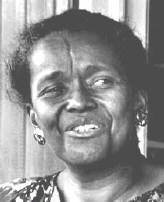 | FROM THE
GRASSROOTS UP
After the boycott ended, King joined with more than 100 ministers and civil rights
leaders in 1957 to found the Southern Christian Leadership Conference (SCLC) . The purpose of
the SCLC, as stated by King, was “to carry on nonviolent crusades against the evils of
second-class citizenship .” Using African-American churches as a base, the SCLC planned to
stage protests and demonstrations throughout the South.
Leaders of the SCLC hoped to build a
movement from the grassroots up and to win the support of ordinary African Americans of all ages.
King, president of the SCLC, used the | power of his
voice and ideas to fuel the movement’s momentum. The nuts and bolts of organizing the SCLC fell
to Ella Baker, a former NAACP activist and the granddaughter of a slave minister .
While with the
NAACP, Baker had served as national field secretary, traveling over 16,000 miles throughout the South
. From 1959 to 1961, Baker used her contacts to set up branches of the SCLC in 65 Southern cities .
In April 1960, Baker helped students at Shaw University, an African-American university in Raleigh,
North Carolina, to organize the Student Nonviolent Coordinating Committee, or SNCC, pronounced
“snick” for short. It had been six years since the Brown case, and many college
students viewed the pace of change as too slow. Although these students risked a great deal-losing
college scholarships, being expelled from college, being physically harmed-they were determined to
challenge the system . SNCC, which hoped to harness the energy of these student protesters, would
soon create one of the most important student activist movements in the nation’s
history. | | |
|
|
|
92.
|
The Southern Christian
Leadership Council (SCLC) was a _____ based organization.
a. | church | c. | civic | b. | student | d. | business |
|
|
|
93.
|
Who was the organizer of the
Southern Christian Leadership Council?
a. | Rosa
Parks | c. | Martin Luther
King | b. | Ella Baker | d. | Thurgood Marshall |
|
|
|
94.
|
Why was Student Nonviolent
Coordinating Committee, or SNCC organized?
a. | Students were demanding more
scholarships | c. | Students thought
the pace of integration was too slow | b. | Students did not want to integrate with white
students | d. | Students thought the Southern
Christian Leadership Conference was moving too fast and not paying attention to concerns of
students. |
|
|
|
The Movement
Spreads
Although SNCC
adopted King’s ideas in part, its members had ideas of their own. Many wanted a more
confrontational strategy and set out to reshape the civil rights movement.
In those days there
were stores called 5 and dimes. Many of these stores had lunch counters where shoppers could each
lunch. Originally KMart was a 5 and dime called Kresgies | | DEMONSTRATING FOR FREEDOM
The founders
of SNCC had models to build on . In 1942, the Congress of Racial Equality (CORE) had staged the first
sit-ins, in which African-American protesters sat down at segregated lunch counters in Chicago and
refused to leave until they were served . In February 1960, African-American students from North
Carolina’s Agricultural and Technical College staged a sit-in at a whites-only lunch counter at
a Woolworth’s store in Greensboro . This time, television crews brought coverage of the protest
into homes throughout the United States . Day after day, reporters captured the ugly face of
racism-scenes of whites beating, jeering at, and pouring food over students who refused to strike
back. The coverage sparked many other sit-ins across the South. Store managers called in the
police, raised the price of food, and removed counter seats. But the movement continued and spread to
the North. There students formed picket lines around national chain stores that maintained segregated
lunch counters in the South.
NO TURNING BACK
By late 1960, students had descended on and
desegregated Jim Crow lunch counters in some 48 cities in 11 states . They endured arrests, beatings,
suspension from college, and tear gas and fire hoses, but the army of nonviolent students refused to
back down . “My mother has always told me that I’m equal to other people,” said
Ezell Blair, Jr., one of the students who led the first sit-in 1960. For the rest of the 1960s, many
Americans persevered to prove Blair’s mother correct. | | |
|
|
|
95.
|
A Jim Crow lunch counter is one
where
a. | black and whites sat in separate
sections of the same counter | c. | food was served that only white people liked | b. | black people were not allowed to sit and eat with white
people | d. | food was served that only black people
liked |
|
|
|
96.
|
SNCC was comprised mostly of
a. | members of
CORE | c. | young civil rights
activists | b. | older veterans of the civil rights movement | d. | members of SCLC |
|
|
|
97.
|
Why didn’t the sit-in
demonstrators fight back at the people who jeered and humiliated them?
a. | They were following the principles
taught by Marcus Garvey | c. | They were afraid
of the anti-sit in demonstrators | b. | They were following the lessons of taught by Martin Luther
King | d. | They were afraid of going to Southern
jails |
|
|
|
98.
|
CORE is an old civil rights
organization that has been working for racial equality for many years. CORE stands for
a. | Colored Organization of Racial
Enthusiasts | c. | Congress Of Racial
Entigration | b. | Congress of Old Racial Energy | d. | Congress of Racial Equality |
|
|
|
99.
|
Demonstrations organized by the
SCLC were effective but SNCC demonstrations were not.
|
|
|
100.
|
In the 1960’s most
Americans outside the South were unaware of the civil rights movement.
|
|
|
African Americans Seek Greater
Equality
By 1965, the leading
civil rights groups-while still sharing the goals of racial equality and greater opportunity-began to
drift apart. New leaders emerged as the civil rights movement turned its attention to the North,
where African Americans faced not legal racism but deeply entrenched and oppressive racial prejudice
nonetheless.
NORTHERN SEGREGATION The problem in the North was de facto segregation-
segregation that exists by practice and custom . De facto segregation can be harder to fight than de
jure segregation (segregation by law), because eliminating it requires the transformation of racist
attitudes rather than the repeal of Jim Crow laws. Activists in the mid-1960s would find it much more
difficult to convince whites to share economic and social power with African Americans than to
convince them to share lunch counters and bus seats.
De facto segregation intensified after African Americans
migrated to Northern cities after World War 11. This began a “white flight,” in which
great numbers of white city dwellers moved to the suburbs . By the mid-1960s, most urban African
Americans found themselves trapped in decaying slums, paying rent to landlords who often refused to
comply with local housing and health ordinances . The schools provided for African-American children
deteriorated along with their neighborhoods . Unemployment rates among African Americans were more
than twice as high as those among whites . The widely publicized gains in voting rights and
desegregation of public accommodations made many urban African Americans impatient for discrimination
in other areas to end. In addition, they were angry at the sometimes brutal treatment they received
from the mostly white police force that patrolled their communities
.
| |
|
|
|
101.
|
By 1965 the civil rights
leaders turn their attention _____ where another kind of racism existed.
a. | to the
West | c. | to the
farmlands | b. | to the North | d. | outside of America |
|
|
|
102.
|
Segregation that is in place by
custom and tradition, but not necessarily by law is called
a. | local
segregation | c. | de facto
segregation | b. | national segregation | d. | state segregation |
|
|
|
103.
|
When black people moved into
Northern cities after World War II, what did white residents do?
a. | Fought integration by going to
court | c. | Joined the
KKK | b. | Refused to sell their houses to blacks | d. | Fled to the Suburbs |
|
|
|
104.
|
In the 50’s and early
60’s white people had most of the good jobs and paid most of the city taxes. What happened to
the cities when the whites moved out?
a. | the cities lost their tax
base | d. | all of these
happened | b. | the cities turned into giant slums | e. | none of these things happened. White people did not pay most of the
taxes. | c. | the cities went broke |
|
|
|
105.
|
De Facto segregation is harder
to control than legal segregation, such as Jim Crow laws.
|
|
|
URBAN VIOLENCE ERUPTS
In New York City in July
1964, a clash between white police and African-American teenagers ended in the death of a 15-year-old
student . This incident sparked a race riot in central Harlem . Similar conflicts took place in other
cities during that year. On August 11, 1965, only five davs after President Johnson signed the Voting
Rights Act into law, African Americans in Los Angeles exploded in anger against white authority. In
Watts, the city’s predominantly African- American neighborhood, police who were arresting a
voting man for drunk driving argued with the suspect’s mother before on-lookers . A riot broke
out that lasted for six days. Thirty-four people were killed, and property valued at about $30
million was destroyed, making the Watts riot one of the worst race riots in the nation’s
history. The next! year, 1966, saw even more racial disturbances, and 1967 \vas the most violent year
of all. In 1967 alone, riots and violent clashes took place in more than 100 cities north and south,
east and west. The rage that African Americans were expressing baffled many whites, who could not
understand why blacks would turn to violence just after winning so many important civil rights
victories in the Smith . Some white leaders, however, realized that what African Americans wanted and
needed was economic equality of opportunity in jobs, housing, and education .
As early as
January 1964, even before the riots, President Johnson announced to Congress his War on Poverty, a
program designed to help impoverished Americans of all races. But war in far-off Vietnam, a Southeast
Asian country where
| 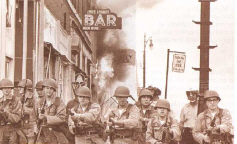
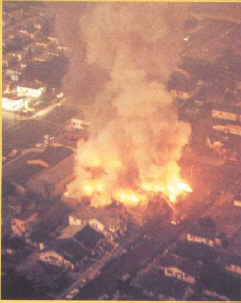
the United States sent troops to fight Communists, soon
siphoned off the money needed to fund what Johnson called the Great Society. In a fiery antiwar
speech in 1967, Dr. Martin Luther King, Jr., declared, “The Great Society has been shot down on
the battlefields of Vietnam | | |
|
|
|
106.
|
In this passage, the authors
make assertions about the causes for riots by African Americans in the 1960s. Their explanations are
a. | factual | c. | the only possible
explanations | b. | theories |
|
|
|
107.
|
What did Dr. Martin Luther King
blame for the urban riots by African Americans?
a. | poverty in the African American
communities | c. | segregation in the
North | b. | the draft, which sent many young black men to
Vietnam | d. | a lack of voting rights in the
North |
|
|
|
108.
|
President Johnson was expert at
getting laws passed in congress. Why didn’t he get a poverty law passed to help people in the
African American in inner cities?
a. | He lost interest in civil
rights | c. | Because of the war in Vietnam there
was no money left for a war on poverty | b. | He was angry with African Americans for
rioting | d. | He thought it was unconstitutional for the U.S. government
to get involved in state matters. |
|
|
|
109.
|
Martin Luther King was _____
the war in Vietnam
a. | against | c. | unconcerned | b. | in favor of | d. | pro communist in |
|
|
|
New Leaders Voice
Discontent
The anger that sent
rioters into the streets stemmed in part from African-American leaders who were reviving the belief
that African Americans should take complete control of their communities, livelihoods, and culture.
One such leader, Malcolm X, brought a Harlem audience to its feet in the early 1960s when he
declared, “If you think we are here to tell you to love the white man, you have come to the
wrong place.”
AFRICAN-AMERICAN SOLIDARITY Malcolm X, born Malcolm Little, went to jail at age 20 for
burglary. While in prison, he studied the teachings of Elijah Muhammad, the head of the Nation of
Islam, or the Black Muslims. Malcolm changed his name to Malcolm X (dropping what he called his
“slave name”) and, after his release from prison in 1952, became a minister of the
Islamic religion. Soon he was one of Elijah Muhammad’s most famous disciples . A brilliant
thinker and an engaging speaker, Malcolm X openly preached Elijah Muhammad’s views that whites
were the cause of the condition in which blacks found themselves and that blacks should separate from
white society.
Malcolm’s
message appealed to many African Americans and their growing pride in their identity. At a New York
press conference in March 1964, he also advocated armed self-defense .
The press gave a great deal
of publicity to Malcolm X because his controversial statements made dramatic news stories . This
publicity had two effects . First, his call for armed self-defense frightened most whites and many
moderate African Americans. Second, reports of the attention Malcolm received awakened resentment in
some other members of the Nation of Islam. | Malcolm X
changed his mind about white people when he went to the middle east and saw many white Muslims. The
leaders of the Black Muslims in America turned against him. He was assassinated in
1965 | | |
|
|
|
110.
|
Where did Malcolm X learn about
the Muslim religion?
a. | In the African American community in
Harlem | c. | In the African American Baptist
churches | b. | In prison | d. | In College |
|
|
|
111.
|
Until his death, Malcolm X
taught
a. | hatred of white
people | c. | African Americans to be proud of
themselves | b. | black people to emigrate to the middle east | d. | African Americans that they should riot against
poverty |
|
|
|
112.
|
Who was leader of the Black
Muslims in America
a. | Malcolm
X | c. | Muhammad
Ali | b. | Martin Luther King | d. | Elijah Muhammad |
|
|
|
BALLOTS OR
BULLETS?
In March 1964,
Malcolm broke with Elijah
Muhammad over differences in strategy and doctrine and formed another Muslim
organization. One month later, lie embarked on a pilgrimage to Mecca, in Saudi Arabia, a trip
required of followers of orthodox Islam. In Mecca, he learned that orthodox Islam preached the
equality of all races, and he worshiped alongside people from many countries. Wrote Malcolm, “I
have [prayed] . . . with fellow Muslims whose eyes were the bluest of blue, whose hair was
the blondest of blond, and whose skin was the whitest of white.” The experience radically
changed Malcolm’s thinking . When he returned to the United States, he still burned with a
hatred of racism and injustice, but his attitude toward whites had changed. When 1965 opened, he
introduced a new slogan : “Ballots or bullets.” In explaining the phrase, Malcolm told a
follower, “Well, if you and I don’t use the ballot, we’re going to be forced to use
the bullet. So let us try the ballot.”
Malcolm believed that his life might be in danger because
of his split with the Black Muslims . “No one can get out without trouble,” he confided
to a friend. On February 21, 1965, Malcolm X walked into Harlem’s Audubon Ballroom to address a
crowd of about 400 followers . No sooner had he begun speaking than three men rushed forward and shot
him down. At age 39, Malcolm X was dead
| |
|
|
|
113.
|
Ballots or Bullets means
...
a. | Kill the
politicians | c. | vote for gun
rights | b. | Political power or riots | d. | only people who vote have a right to own a
gun |
|
|
|
114.
|
The Black Muslim leadership
changed their views, along with Malcolm X
|
|
|
115.
|
From the reading we can tell
that Malcolm X was
a. | rigid and
unyielding | c. | easily manipulated
by white people | b. | compromising and violent | d. | flexible and intelligent |
|
|
|
BLACK POWER
In early June of 1966, tensions that had been building between SNCC and the
other civil rights groups finally erupted in Mississippi . Here, James Meredith, the man who had
integrated the University of Mississippi, set out on a 220-mile “march against fear.”
Meredith planned to walk all the way from the Tennessee border to Jackson. But on the second day of
Meredith’s march, a white man stopped him by firing a round of birdshot into his head, legs,
and back. Meredith was too injured to continue .
Dr. Martin Luther King, Jr., of the SCLC,
Floyd McKissick of CORE, and Stokely Carmichael of SNCC decided to lead their followers in a march to
finish what Meredith had started . It soon became obvious that SNCC and CORE participants were quite
militant, as they began to shout slogans similar to those of the black separatists who had followed
Malcolm X. When King tried to rally the marchers with the familiar refrain of .We Shall
Overcome,” many SNCC workers-bitter over the violence they’d suffered during Freedom
Summer-drowned out the song by singing, “We shall overrun.”
On the night of June 17,
police in Greenwood, Mississippi, arrested SNCC leader Stokely Carmichael for setting up a tent on
the grounds of an all-black high school . That night marchers | held a hastily organized rally to protest
Carmichael’s arrest. Near the end of the rally, he showed up on the platform, with his face
swollen from a beating . The stunned crowd listened as Carmichael spoke.
The slogan Black Power
electrified the night marchers. Some civil rights leaders, including King, urged Carmichael to stop
using it because they believed it would provoke African-American violence and antagonize whites.
Carmichael refused to heed their warnings. Black Power, he said, was a “call for black people
to begin to define their own goals . . . [and] to lead their own organizations .” He
urged SNCC to stop recruiting whites and to focus on developing African- American
pride
| 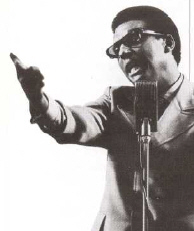 | | |
|
|
|
116.
|
The members of SNCC agreed with
the non-violent approach to civil rights taught by Martin Luther King
|
|
|
117.
|
SNCC and CORE were more
interested in _____ than integration
a. | black
power | c. | religious
reform | b. | poverty | d. | housing for blacks |
|
|
|
118.
|
Stokely Carmichael was the
leader of
a. | CORE | c. | NAACP | b. | SCLC | d. | SNCC |
|
|
|
119.
|
Stokley Carmichael was
concerned about the effect of SNCC teachings on the white community, which provided most of the money
for the civil rights movement
|
|
|
120.
|
Dr. Martin Luther King
was _____ while Stokely Carmichael was _____
a. | a Baptist - a Black
Muslim | c. | wrong -
young | b. | a moderate - an extremist | d. | aggressive - passive |
|
|
|
121.
|
Which of the following reflects
the political path of Stokely Carmichael?
a. | SNCC organizer Black
Panther | c. | Baptist
minister SCLC organizer | b. | Black Panther SNCC organizer | d. | drug addict and criminal Nation of Islam
minister |
|
|
|
122.
|
The Black Panthers _____ the
idea of racial integration in America.
a. | advanced | c. | advocated | b. | improved | d. | hindered |
|
|
|
BLACK PANTHERS
Later that year,
another development demonstrated the growing radicalism of some segments of the African-American
community. In Oakland, California, in October 1966,
Huey Newton and Bobby Seale founded a
political party known as the Black Panthers to fight police brutality in the ghetto. The party also
offered African Americans what it called “a program for the people,” which advocated
taking control of African-American communities, full employment, and decent housing. The program also
supported an exemption of African Americans from military service-a reflection of the belief that the
government drafted an unfair number of black youths to fight in Vietnam . Most Panthers wore
black berets, sunglasses, black leather jackets, black trousers, and shiny black shoes . To raise
money for the organization, they sold copies of the writings of Mao Zedong, leader of the Chinese
Communist revolu tion. The Panthers publicly preached armed revolt and adopted one of Mao’s
slogans: “Power flows out of the barrel of a gun.” They practiced violence an on one
occassion murdered a public official on his doorstep, in front of his family. While they advocated
many ideas for helping the people, in fact they did very little except preach hate and violence. Like
the KKK they were a hate group that set back the cause of civil rights in America.
Most public
officials and political leaders feared and distrusted the Panthers and objected to their
revolutionary rhetoric . Several shootouts occurred between the Panthers and the police, and the FBI
conducted investigations of the organization as they had on the KKK . The Panthers also drew
recruits from SNCC, including Stokely Carmichael, who joined the party in June
1967. |
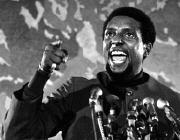
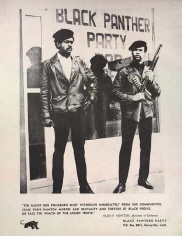 | | |
|
|
|
123.
|
Who founded the Black
Panthers?
a. | Huey Newton and Bobby
Seale | c. | Bobby Seale and Angela
Davis | b. | Huey Newton and Malcom X | d. | Martin Luther King |
|
|
|
124.
|
The Black Panthers were to the
Black Community as the ______ was to the White Community.
a. | NAACP | c. | Republicans | b. | KKK | d. | Democrats |
|
|
|
125.
|
Which group below might best be
compared to the Black Panthers because of their beliefs and tactics.
a. | Socialists | c. | the Nazi party in Germany | b. | Members of the SCLC | d. | the Democratic party in the U.S. |
|
|
|
126.
|
Supreme Court Decision that said the 14th Amendment did not apply to a law that said
Black and White people should be segregated on trains. Formed the legal basis for Southern
Segregation a. | McCullah vs.
Maryland | c. | Brown vs. Board of
Education | b. | Plessy v. Ferguson | d. | None of the above |
|
|
|
127.
|
Says that the law must be applied equally to all persons in the
U.S a. | 14th Amendment | c. | Brown v. Board of
Education | b. | 15th
Amendment | d. | Jaime
Mastascuso |
|
|
|
128.
|
National Association for the
Advancement of Colored People
a. | NAACP | c. | NBA | b. | NAAFTAOCP | d. | NCAA |
|
|
|
129.
|
Argued the Brown v. Board of
Education case in front of the Supreme Court and won. Later appointed to the U.S. Supreme Court
himself.
a. | Stokley
Carmichael | c. | Martin Luther
King | b. | Malcolm X | d. | Thurgood Marshall |
|
|
|
130.
|
NAACP officer who took a seat
in front of bus in violation of local law. Was arrested. Event helped to spark the Civil Rights
movement
a. | Elana
Watts | c. | Rosa
Parks | b. | Maryann Anderson | d. | Sara Parks |
|
|
|
131.
|
Led by Martin Luther King,
African Americans refused to ride the busses until they were desegregated.
a. | Georga Bus
Boycott | c. | Montgomery Bus
Boycott | b. | Little Rock Bus Boycott | d. | Greyhound Bus Boycott |
|
|
|
132.
|
Non-violent protest against
segregation and discrimination
a. | Soul
force | c. | Black
power | b. | Soul Sacrifice | d. | Cool protest |
|
|
|
133.
|
SCLC
a. | South Carolina Leadership
Council | c. | Southern Christian
Leadership Council | b. | Southern Children Leadership Council | d. | Save the Children Leadership
Council |
|
|
|
134.
|
Primary leader of the Civil
Rights Movement. Assassinated in 1968
a. | Stokley
Carmichael | c. | James
Meredith | b. | Martin Luther King | d. | Malcolm X |
|
|
|
135.
|
The Student Non-violent
Coordinating Committee
a. | SSNCC | c. | SNCC | b. | SSNVCC | d. | SNOCC |
|
|
|
136.
|
Won court case admitting him to
Ole Miss University. The school refused to admit him. Touched off riots
a. | Clarence
Thomas | c. | Stokley
Carmichael | b. | James Brown | d. | James Meredith |
|
|
|
137.
|
1963 March where 250,000
marched for civil rights. Dr. King gave famous “I Have a Dream”
speech.
a. | March on
Montgomery | c. | March on
Philadelphia | b. | March on Washington | d. | March on Birmingham |
|
|
|
138.
|
Prohibited discrimination
because of race, religion, national origin, and gender
a. | Civil Rights Act of
1964 | c. | Brown v. Board of
Education | b. | Civil Rights Act of 1954 | d. | Social Security Act |
|
|
|
139.
|
Eliminated the literacy test
for voting.
a. | Civil Rights Act of
1964 | c. | Voting Rights Act of
1965 | b. | Civil Rights Act of 1965 | d. | 25th
Amendment to Constitution |
|
|
|
140.
|
Segregation that exists by
custom and tradition rather than by law
a. | De facto
segregation | c. | Black
codes | b. | De jure segregation | d. | Socialism |
|
|
|
141.
|
Segregation the exists by
law
a. | De facto
segregation | c. | Black
Codes | b. | De jure segregation | d. | Communism |
|
|
|
142.
|
Nation of Islam leader who
began by preaching Black/White separation. After trip to Mecca changed views on separation and
advocated Black identification with Africa
a. | Elijah
Mohammad | c. | W.E.B.
Dubois | b. | Mohammad Ali | d. | Malcom X |
|
|
|
143.
|
SNCC leader who advocated
Violence rather than non-violence to achieve civil rights goals
a. | Thurgood
Marshall | c. | Malcom
X | b. | Medger
Evers | d. | Stokley
Carmichael |
|
|
|
144.
|
Founded by Bonny Seal and Huey
Newton. Advocated militancy and violence to achieve goals
a. | SNCC | c. | NAACP | b. | SNICK | d. | Black Panthers |
|
|
|
145.
|
Banned discrimination in
housing
a. | Civil Rights Act of
1964 | c. | Civil Rights Act of
1968 | b. | Voting Rights Act of 1965 | d. | Fair Housing Law of 1966 |
|
|
|
146.
|
Special efforts to recruit
minorities into jobs and colleges.
a. | Affirmative
Action | c. | De facto
outreach | b. | Black Codes | d. | De jure outreach |
|